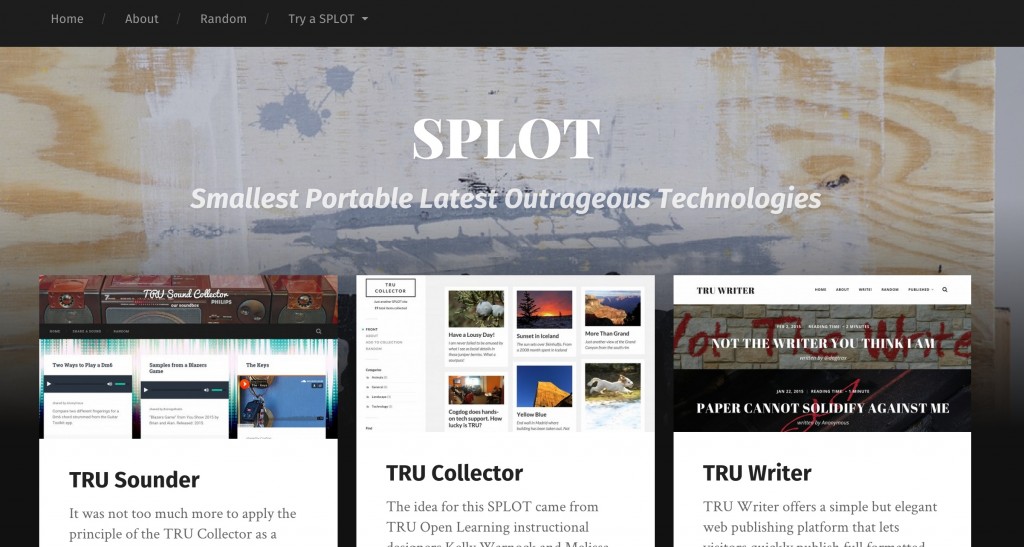 If you’re from the edtech world I assume you’ll know of the great work of old friends Alan Levin and Brian Lamb (and others, ommissions solely out of ignorance) on the idea of SPLOTs, possibly standing for “Smallest Possible Learning Online Tool.” How that idea/approach came to be is surely a long story. I can’t find the single origin story from any of these folks, if indeed there is a single one, but my own take would be that it’s a combination and culmination of open web/small-pieces-loosely-joined/”learning as creating” thinking they’ve been doing for years, combined with long-time frustrations with the monolith that is the enterprise LMS (and its overly complex integration approach), the privacy nightmare that is the web and finally with some inspiration from other sectors who are also promoting simple to use web-based content creation tools.
If you’re from the edtech world I assume you’ll know of the great work of old friends Alan Levin and Brian Lamb (and others, ommissions solely out of ignorance) on the idea of SPLOTs, possibly standing for “Smallest Possible Learning Online Tool.” How that idea/approach came to be is surely a long story. I can’t find the single origin story from any of these folks, if indeed there is a single one, but my own take would be that it’s a combination and culmination of open web/small-pieces-loosely-joined/”learning as creating” thinking they’ve been doing for years, combined with long-time frustrations with the monolith that is the enterprise LMS (and its overly complex integration approach), the privacy nightmare that is the web and finally with some inspiration from other sectors who are also promoting simple to use web-based content creation tools.
All of which is to say – it’s one of the few things in ed tech that has my attention, and because “do whatever @cogdog does1” has always served my career well, I decided to steal the idea and re-purpose for the library world.
I started off a few months back emailing some Co-op staff for ideas, asking for the simplest use cases they could think of and pointing to a few examples I had found, like Thomas Meehan’s MARC viewr http://www.aurochs.org/mrv/mrv.html or Mike Field’s SIP testing tool http://www.clcohio.org/sip-testing-tool (though it has no web interface). I also searched some of the usual places I know in the open source library world, and found a few possibilities amongst code4lib’s wiki and the library carpentry site. Staff had a few ideas too, like a “system control number or human-readable mnemonic generator (example gfycat’s gfynames)” or a “web-based OAI harvester that lets you filter through payloads by some criteria or does some pre-parsing for you.”
So the set of possible ideas was growing, but not certain either a) how many of them would be useful to wider audience of librarians or b) how “simple” they were. Maybe in aiming at tools for librarians I’d picked an inherently complicated (or not web-amenable) set of problems to solve, but I don’t think so.
![]() Instead of giving up, I got the spur of the moment idea to workshop the idea at BC’s 5th annual code4lib gathering. code4lib very much reminds me of BC’s ETUG in the old days – a nice grassroots mix of hands on technologists sharing demos along with a good number technically inclined or interested users (in this case librarians instead of educators) wanting to learn more. So on the second day I proposed a lightning talk which was basically a 2 minute overview of the SPLOT idea and a pitch to come to an afternoon breakout session to brainstorm some further ideas for library-oriented SPLOTs.
Instead of giving up, I got the spur of the moment idea to workshop the idea at BC’s 5th annual code4lib gathering. code4lib very much reminds me of BC’s ETUG in the old days – a nice grassroots mix of hands on technologists sharing demos along with a good number technically inclined or interested users (in this case librarians instead of educators) wanting to learn more. So on the second day I proposed a lightning talk which was basically a 2 minute overview of the SPLOT idea and a pitch to come to an afternoon breakout session to brainstorm some further ideas for library-oriented SPLOTs.
I was pretty please we got maybe 15 or so folks to the afternoon session and in just over an hour came up with a number of other ideas. Based on all of these inputs I’d say there are at least 3 or 4 viable contenders that I’ll start working on.
But for now all you get is this blog post. I have always admired Alan’s approach of “just sharing” the things he’s built instead of endless talking and planning to share, and don’t want to fall into that trap. But I wanted to write something a) to make a public commitment to keep going with this b) to create a place for library folks to add other ideas, as I know a few said they had some but couldn’t attend the breakout session.
1 actually the original quote is “Do what ever @dlnorman does,” but he’s laser focused on PhD and family right now, as he should be, so we don’t get to hear what that is very often anymore #IMissD’Arcy

I might suspect you are fishing for comments 😉 Here is your SPLOT origin story. They were hatched during my Open learning Fellowship at TRU Oct 2014-March 2015, all work then portfolio-ized at http://cogdog.trubox.ca
It’s mentioned first October 28, 2014 https://cogdog.trubox.ca/2014/10/28/what-the-splot/
The conversation definitely was over beers at the Fox and Hound. My flickr photos that I arrived in Kamloops the afternoon of Friday October 23, that weekend was the sad in retrospect last visit to his house on the lake. It’s likely the conversation happened the night before that blog post, October 27 when Brian and I started talking about the work I might do at TRU.
Or maybe it was the 28th- here is Brian’s Tweet from 3:18pm in the afternoon. Maybe I wrote my blog post at the Fox and Hound
https://twitter.com/brlamb/status/527223001482133504
One part of that was running a “ds106 for faculty PD” which became The You Show http://youshow.trubox.ca the other was the idea, and Brian definitely spoke the name and acronym that night, prefaced by “I know you will hate this but…”
More summary from our Open Web presentation
The premise than was ease of entry/simplicity of tool (which I like saying now as small single use tools). There was also the common issue of putting a great tool like WordPress in front of people, and watch their eyes glaze over trying to explain the dashboard and differences between posts and pages and…
The other desire was tools that did not explicitly require supplying user information to use. We spoke that night of Tom Woodward’s brilliant projects using Gravity forms as a front end for people to create/contribute content to WordPress sites w/o needing to go through the dashboard. That might have been as far as the conversation went besides deciding to register the splot.ca domain (run then under Brian’s Reclaim Hosting account).
Brian was soon on his way to Australia for a conference, leaving me time to tinker. That was the beauty of the TRU fellowship, it was more like a sabbatical as I had full time just to experiment, not to do other people’s projects or web sites. I was given a TRU office I almost never used, I did most of the development in the student center coffee shop, looking out across the mountains on the other side of town.
The first SPLOT was inspired again some by Tom, as well as one of the Knight News Tools, the image comparison tool- I first built it in HTML jQuery just to figure it out.
https://cogdog.trubox.ca/2014/10/31/splotting-the-comparator/
Of course, just mention HTML or jQuery and most people will run away. That’s not the solution. I had in mind that WordPress had everything needed to make this easier, as it manages image uploads- all you need are two images of the same dimensions. The stumbling block was that unless you did form upload, there was no way for a non logged in user to access the WordPress media uploader, which provides the auto image resizing needed.
And this was the breakthrough, figuring out how to secretly log in a visitor as a generic author, hiding the admin bar and the dashboard, just to provide front end access to the media uploader, blogged on November 18, 2014
https://cogdog.trubox.ca/2014/11/18/splaining-splot/
The rest of the story is rolled out via https://cogdog.trubox.ca/category/tangibles/projects/splot/
I draw much pleasure that people take an interest in SPLOTs while they still have no firm definition. I hope they can resist one. All SPLOT-like things are good. I really dig the Knight Tools for what they provide as a single purpose tool, though I think what it takes to put into your own work, short of WordPress plugins, present a barrier.
I also love the platform independent approach of H5P and plan to explore them more after doing some intro workshops last month. They are definitely small tools, to be they are more widgets, but at least they extend what you can do in a platform.
I would say that SPLOTS need not be the WordPress based approach I did for the first batch, though I’ve not done any new ones any other way. I’d say what makes the ones I worked on a little different from any small tool is that (a) no technical skill is required to set up beyond WordPress installation, theme set up (which can easily done for others in a multisite environment or the cloning approach being done at Coventry). But more so, they also are multi-person tools, they potentially create sites where all content created is public and shared (SPLOTpoint might be an exception).
Yikes, my comment turned into a blog post. Maybe I’ll post at home too.
I am excited to see what kind of ideas emerge from your thinking here. The world can always use more SPLOTheads.
Alan is always overly kind to me.
I took a look through some of your suggested SPLOTs and tried to do something useful for the ones that didn’t seem to library specific for me to understand.
Do you have any example text you’d like the line breaks stripped from? I didn’t actually do anything yet and this seems to do a fair job (although maybe too much stripping?).
I started to do the contrast ratio for accessibility piece but found this which seems very nice and might not even need tweaking although it is on GitHub so that’s handy.
I’m pretty sure the pastebin piece would be easy to implement in WordPress but would take a bit more time than I’ve got tonight.
In any/all cases, love that you’re playing with SPLOTs. I love the idea more each day.
Also I was messing with an API-based text view because I thought I might learn something.
I made a rough example here that shows the raw HTML of WP posts. It might/might not be the kind of text blob you want.
Tom, this is very cool, I will mess around with more of these when I get off the road next week. Thanks for the leads (and the leadership!) S